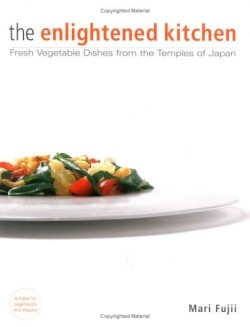The Enlightened Kitchen
Fresh Vegetable Dishes from the Temples of Japan
Americans have submitted to increasingly frantic, contradictory food fads in pursuit of a healthy diet. From banishing carbs, to factory-made dietetic meals (vacuum-sealed in plastic), and synthetic fat substitute (notorious for inducing diarrhea), dieters have tried it all. In this country of wild excess, the meals are super-sized, but still oddly unsatisfying. At first glance, it might seem counter-intuitive that the capacity to savor, and thus to feel deeply indulged, could be restored by monastic Zen food ways—conventionally perceived as the epitome of the austere. Buddhist precept prohibits the killing of things “that flee when chased,” and Japanese temple cuisine is resolutely vegetarian. Yet this book reveals shojin ryori, or Japanese temple food, to be an act of celebration, rather than renunciation.
The author recounts how mealtimes have traditionally offered monks the “only moments of relief” during long days of rigorous training. The wife of a Kamakura Buddhist monk and tenzo, or temple cook, Fuji is an expert on the ancient secrets of temple food. For many years on Japanese television and in her cookbooks, she has rendered its pleasures and preparation methods accessible to the public outside the monastery walls.
Among temple cuisine’s primary tenets is that eating food in its season provides the essential nourishment at any given time of year. Summer produce from the melon family, such as tomatoes, eggplants, and cucumbers, is believed to cool the body, whereas in winter, priests turn to root vegetables for warmth and ballast. In the era of global hothouse agriculture, temple food continues to pay homage to season and place. By honoring the moment and the environment, even the simplest, everyday fare becomes a thanksgiving meal.
The average US reader might imagine that it would be daunting to serve Buddhist temple cuisine to family and friends. But The Enlightened Kitchen demystifies what could otherwise sound difficult and exotic. Essentially, Fuji is writing about old-fashioned comfort food. The basic temple meal consists of one soup and one dish, accompanied by rice. The author provides lucid, time-efficient recipes for savory, earthy fare such as fried pumpkin with peanut sauce, shiitake sushi, eggplant in sesame sauce, and ginger rice. Fans of Japanese cuisine will appreciate her recipe for veggies with red miso dip, a staple of Japanese izakaya, or pubs—and one of the most healthful and delicious snacks in existence.
In the West, vegetarian fare has too often been limited to the ubiquitous nut loaf and badly abused tofu. Buddhist temple cooks, on the other hand, have taken thousands of years to develop a highly refined vegetarian cuisine—infinite in its variety, textures, and flavors. The Enlightened Kitchen passes the ultimate litmus test: non-vegetarians won’t go hungry here. Temple cuisine is beautifully presented in this volume’s photographs, with the vibrant hues of vegetables against dark pottery—like a miniature Zen landscape on a plate. On every level, this book serves up a feast.
Reviewed by
Melanie Drane
Disclosure: This article is not an endorsement, but a review. The publisher of this book provided free copies of the book to have their book reviewed by a professional reviewer. No fee was paid by the publisher for this review. Foreword Reviews only recommends books that we love. Foreword Magazine, Inc. is disclosing this in accordance with the Federal Trade Commission’s 16 CFR, Part 255.

